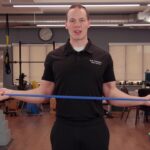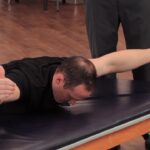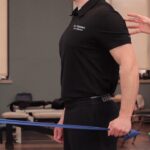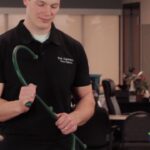Pull Apart: Straight & Bent Arm | Early Intervention Ergonomics
What is the Pull Apart: Straight & Bent Arm Stretch?
The Pull Apart: Straight & Bent Arm with a Band exercise is a resistance band exercise that primarily targets the muscles of the upper back, shoulders, and arms. It is a great exercise for improving posture, strengthening the shoulder girdle, and enhancing upper body stability.
Here’s how to perform the Pull Apart Straight & Bent Arm exercise:
- Start by standing with your feet shoulder-width apart and grasping a resistance band with both hands. Hold the band in front of you, keeping your palms facing downward and your arms extended straight out in front of your body.
- Maintain a slight bend in your elbows and engage your core for stability.
- Begin the exercise by simultaneously pulling the band apart with both hands, moving your arms out to the sides. Imagine squeezing your shoulder blades together as you do this, focusing on engaging the muscles of your upper back. Hold for 2-3 seconds, then relax.
- Another variation is to turn the band over with your palms facing up. Proceed with the stretch as instructed previous steps 1-3.
- Slowly return your arms back to the starting position, controlling the resistance of the band. Keep tension on the band throughout the movement.
- For the Bent Arm Variation, start with palms up and hands a little closer together. Keep your elbows tight against your side. Set your shoulder blades back again, then pull your hands apart keeping those elbows tight against your side.
- Repeat the exercise for 10-15 repetitions.
It’s important to maintain proper form throughout the exercise. Avoid shrugging your shoulders or letting your back excessively arch. Focus on using the targeted muscles to perform the movement.
As with any exercise, it’s recommended to start with lighter resistance bands and gradually increase the tension as your strength improves. If you’re unsure about performing this exercise or have any specific concerns, it’s always a good idea to consult with a fitness professional for guidance.
Early Intervention Benefits of this Exercise
The Pull Apart Straight Arm & Bent Arm with a Band exercise offers several early intervention benefits for the muscles targeted and overall upper body strength and stability. Here are some of the key benefits:
- Upper back and shoulder strengthening: The exercise primarily targets the muscles of the upper back, including the rhomboids, rear deltoids, and middle trapezius. It helps to strengthen these muscles, improving posture, and promoting better upper body alignment.
- Shoulder stability: By engaging the muscles around the shoulder girdle, including the rotator cuff muscles, the exercise enhances shoulder stability. This can be particularly beneficial for individuals involved in work activities that require overhead movements.
- Improved posture: The exercise helps counteract the effects of rounded shoulders and forward head posture, which are common issues due to modern lifestyle factors like prolonged sitting and desk work. Strengthening the upper back muscles can promote better posture and alignment.
- Shoulder joint mobility: Performing the exercise with a resistance band requires a controlled range of motion, which can contribute to maintaining and improving shoulder joint mobility. It helps to prevent stiffness and enhance overall shoulder flexibility.
- Versatility and accessibility: The exercise can be performed with a resistance band, which is a portable and affordable piece of equipment. It allows for a wide range of resistance levels, making it suitable for people of different fitness levels and abilities.
- Injury prevention: Strengthening the upper back and shoulder muscles can serve as a preventive measure against common injuries, such as shoulder impingement and postural imbalances. The exercise can also be used as part of a rehabilitation program for certain shoulder and upper back conditions.
Remember, consistency and proper form are key when performing any exercise. Gradually increasing resistance as you build strength and seeking guidance from a fitness professional can help you maximize the benefits of this exercise while minimizing the risk of injury.
If you have an injury or illness, consult with a health care professional before attempting.
These early intervention exercises are vital to improve overall health and fitness as well as reduce work-related injuries.
More Tools & Resources from Peak Ergonomics
Contact Us About Reducing Workplace Injuries
Healthy Employees are the Bottom Line! – Learn More!







